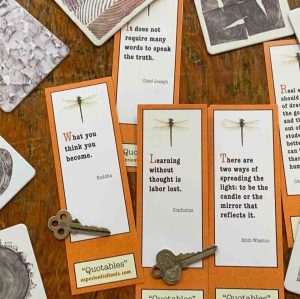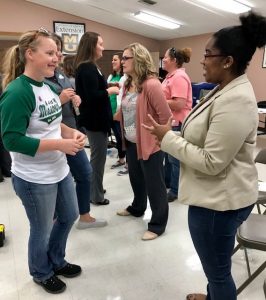Apr 11, 2019 Beware of the Icebreaker — Make Thoughtful Activity Choices
Some educators operate with the idea that stress increases people’s ability to learn and be creative. There are many icebreakers, games, and initiatives used in group work that are designed to quickly push people out of their comfort zones in order to initiate learning. Unfortunately, some of these activities push people to perform or share information too early or in a threatening and sometimes inappropriate way, leading to some participants disengage.
There are many ways to avoid these pitfalls and set a positive tone. First, be thoughtful of the language you use as a facilitator. For example, I find myself using the term “rapport-building” instead of ice-breaking, and consciously use language and activities that invite people into an experience rather than “calling on” them to participate.
Begin with a “Hook” to Welcome and Engage Blended with Pair Sharing and Small Group Conversations
Start the group with simpler activities that aren’t overly silly or performance oriented. Include choices about the level of participation. By building trust in this way, group members start to share and engage at their own pace and become more willing to push their comfort zones later on when it really matters. Begin programs with a “hook” or engagement activity as they arrive that they can do at their own pace, and involves autonomy and choice (see my post from the archives “The First Five Minutes” and “Creating Meaning with Metaphor” for ideas for using metaphoric objects for openers to engage).
Neuroscience shows that though we learn from novelty and from being challenged, it needs to be the right amount of challenge at the right time. Brain research is validating John Dewey’s observation about miseducative experiences by showing that stress can inhibit learning (Willis, 2010, 2014). Be aware that any experience designed to push people out of their comfort zone has the potential for the amygdalae (located in the temporal lobes of the brain) to take over and push learners into “fight or flight mode” resulting in checking out or acting out behaviors.
Rather than opening a program with a whole circle introduction I begin rapport building and reflective dialogue with partner or small group sharing activities and start with simple, non-threatening — but relevant, context setting– questions or an object/picture/quote to use as a talking point. This allows participants an opportunity to warm up by interacting with just one or two others at a time before sharing with the larger group.
Create Context, Relevancy, and Meaning from the Start
 Intentionally relating the question or prompt to the group’s purpose builds relevancy and meaning and buy-in. Be thoughtful about designing your “hook” entry activity to create context for the lesson or experience that is coming. John Medina author of Brain Rules states: “If you are trying to get information across to someone, your ability create a compelling introduction may be the most important single factor in the later success of your mission” (2014, p. 116). Educational psychologists have demonstrated that people remember most the first few minutes and the last few minutes of a learning experience (Sousa, 2016; Willis, 2014). Use relevant and rapport-building questions that not only help people get to know each other but create connections relating to the background of the group and purpose of the experience. Many participants complain about that ice-breakers and group building activities that appear to have “no-purpose or meaning.” Whereas, when I’ve blended in meaningful reflective questions into a playful activity like “Handshake Mingle,” I’ve heard from reluctant participants that “this wasn’t like the usual ice-breaker because right away we got to the topic at hand, or I started to understand why we’re having these conversations. This begins the reflective process and helps you weave it throughout your program to increase meaning, buy-in, and depth of understanding.
Intentionally relating the question or prompt to the group’s purpose builds relevancy and meaning and buy-in. Be thoughtful about designing your “hook” entry activity to create context for the lesson or experience that is coming. John Medina author of Brain Rules states: “If you are trying to get information across to someone, your ability create a compelling introduction may be the most important single factor in the later success of your mission” (2014, p. 116). Educational psychologists have demonstrated that people remember most the first few minutes and the last few minutes of a learning experience (Sousa, 2016; Willis, 2014). Use relevant and rapport-building questions that not only help people get to know each other but create connections relating to the background of the group and purpose of the experience. Many participants complain about that ice-breakers and group building activities that appear to have “no-purpose or meaning.” Whereas, when I’ve blended in meaningful reflective questions into a playful activity like “Handshake Mingle,” I’ve heard from reluctant participants that “this wasn’t like the usual ice-breaker because right away we got to the topic at hand, or I started to understand why we’re having these conversations. This begins the reflective process and helps you weave it throughout your program to increase meaning, buy-in, and depth of understanding.
Excerpt from Tips & Tools for the Art of Experiential Group Facilitation 2nd Edition
Dewey J. (1933) How We Think, A Restatement of the Relation of Reflective Thinking to the Educative Process. Boston: D.C. Heath and Co.
Medina, John (2014). Brain Rules: 12 Principles for Surviving and Thriving at Work, Home, and School. Seattle, WA: Pear Press
Sousa, David (2016) How the Brain Learns. Thousand Oaks, CA: Sage Publications
Stanchfield, Jennifer (2014) Inspired Educator, Inspired Learner: Experiential Brain-Based Activities and Strategies to Engage, Motivate, Build Community, and Create Lasting Lessons. Bethany, OK Wood N Barnes Publishing Co.
Stanchfield, Jennifer (2007, 2016) Tips & Tools for the Art of Experiential Group Facilitation. Bethany, OK Wood N Barnes Publishing Co.
Willis, J. (2010) The current impact of neuroscience on teaching and learning. In D.A. Sousa Mind, Brain and Education: Neuroscience Implications for the Classroom (pp.44-66). Bloomington, IN: Solution Tree Press.
Willis, J. (2014) “Brain-based teaching to improve executive functioning.” Lecture conducted at The Learning & the Brain Conference: Engaging 21st Cnetury Minds. Boston, MA.




No Comments